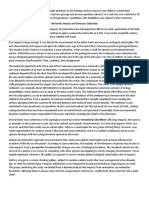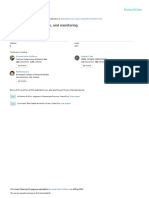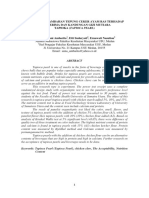Natural Disasters
Natural Disasters
Uploaded by
Chue Sandi Woon SettCopyright:
Available Formats
Natural Disasters
Natural Disasters
Uploaded by
Chue Sandi Woon SettCopyright
Available Formats
Share this document
Did you find this document useful?
Is this content inappropriate?
Copyright:
Available Formats
Natural Disasters
Natural Disasters
Uploaded by
Chue Sandi Woon SettCopyright:
Available Formats
Reading comprehension exercises on the topic “Natural Disasters”
THE ERUPTION OF KRAKATAU
The eruption of the Krakatau (or Krakatoa) on a small
island located in the middle of the Sunda Strait in August 1883 was,
in many aspects, the first global catastrophe.
The news about the eruption, its following tsunami and the
more than 36,000 victims travelled fast thanks to the recently
installed worldwide telegraphic network.
The effects of the eruption were also noted all around the world.
The final explosion of
Krakatau produced the loudest
sound ever recorded in modern history, heard on over 10% of Earth's area. Reports of a distant
cannonade or what seemed to be gunfire were reported from Australia and the island of Mauritius,
more than 4,650 km distant from the erupting volcano. The pressure waves travelled within a few
hours several times around the globe. Instruments measured the sudden peaks in Britain as in
America.
Krakatau produced an eruption column
between 25 and 43 miles high, visible by all ships
passing the Sunda Strait. Within two weeks the ash,
gases and aerosols were blown by atmospheric winds
westwards along the equator. Months after the
eruption the volcanic cloud spread from the equatorial
to the mid-latitude zones. The fine grains, trapped in
the higher layers of earth's atmosphere, scattered the sunlight for many years to come,
causing strange optical phenomena, like blood-red skies.
Krakatau was the first scientifically well recorded and studied eruption of a volcano, from the very beginning to its
disastrous ending.
Unfortunately, nobody realized the real danger of Krakatau. As the island was uninhabitable it was believed that it would
pose no threat to human lives. Between August 26 and 27 a series of explosions almost totally destroyed the volcano, causing a
series of tsunami-waves that killed 36,000 people along the coasts of Java and Sumatra.
The story of Krakatau is still not over. In 1930, in the caldera formed by the explosion
and collapse of the old volcano a new one, Anak Krakatoa, the child of Krakatau, started to grow.
The child has grown fast, displaying a continuous activity since its first eruption it rises by 16 feet
per year and most probably will keep growing.
1. Find the words for the definitions in the text.
1. A sudden outbreak of a volcano - ________________.
2. Long and high sea waves chased by an earthquake or other disaster - _____________.
3. A line dividing the earth into northern and southern hemispheres - _______________.
4. A large volcanic crater - _________________.
2. Mark if the sentence is true or false. 4. Answer the questions.
1. Do you know any other
1. The eruption of Krakatau is thought to be the first global disaster. _________ global disasters?
2. The sound of Krakatau explosion was heard for thousands of kilometers. _______ 2. Are there any disasters
3. The aftereffects of Krakatau eruption were felt only in the Indian Ocean area. _____ people can predict?
4. The scientists had known how dangerous Krakatau volcano might be. _______ 3. Make your predictions:
5. The eruption of Krakatau killed people on the island where the volcano was. _____ A) Will people see the great
6. Now Krakatau is an extinct volcano. _____ eruption of Anak Krakatoa?
B) Will people be able to
3. Tick the aftereffects of the Krakatau eruption. predict and prevent all
disasters in future?
1) tsunami ____ 4) a volcanic cloud _____
2) global warming _____ 5) blood-red skies ______
3) droughts ______ 6) an eruption column _____
You might also like
- Pathways rw3 2e U4 TestDocument12 pagesPathways rw3 2e U4 Testdieuanh100% (2)
- Names - Yi Liu - Bingzheng Xu - Section and TA Info - W2:00 Rui Zhu - GEOG 3A Lab #5: TsunamisDocument6 pagesNames - Yi Liu - Bingzheng Xu - Section and TA Info - W2:00 Rui Zhu - GEOG 3A Lab #5: TsunamisvishalNo ratings yet
- ANAK Krakatau, CompleteDocument57 pagesANAK Krakatau, CompleteSue Bradley100% (8)
- A GALACTIC SUPERWAVE HAZARD ALERT UPDATE - Paul A. LaViolette Nexus2009 PDFDocument16 pagesA GALACTIC SUPERWAVE HAZARD ALERT UPDATE - Paul A. LaViolette Nexus2009 PDFAnonymous 8zZGf0WkNNo ratings yet
- 2011-06-01-The Darkness Chris ThomasDocument6 pages2011-06-01-The Darkness Chris Thomasgero 8780No ratings yet
- The Quiet Life (Poem)Document12 pagesThe Quiet Life (Poem)Chue Sandi Woon Sett100% (1)
- Fetal PositionsDocument4 pagesFetal PositionsNader Smadi100% (1)
- 001-072 MX9859 2014 Catalog Vol2Document72 pages001-072 MX9859 2014 Catalog Vol2IsraelMolinaNo ratings yet
- EruptionDocument2 pagesEruptionHòa VũNo ratings yet
- The Eruption of Krakatau Reading Comprehension Exercises - 114230Document2 pagesThe Eruption of Krakatau Reading Comprehension Exercises - 114230Elena ContrasNo ratings yet
- XREN702 - 4 - Reading - Edwin - Rivera ZapataDocument2 pagesXREN702 - 4 - Reading - Edwin - Rivera Zapataedwin riveraNo ratings yet
- SES66929 Sorawit 11A - Volcanology GAC013Document6 pagesSES66929 Sorawit 11A - Volcanology GAC013SoraOdysseyNo ratings yet
- T.I.Diciembre-6° AÑO EntregarDocument4 pagesT.I.Diciembre-6° AÑO EntregarFrancisco Toro MartinezNo ratings yet
- Krakatoa HomeworkDocument5 pagesKrakatoa Homeworknuqjuuhjf100% (1)
- VolcanoDocument2 pagesVolcanopinkyrochNo ratings yet
- Super Volcano Listening Quiz-230303Document2 pagesSuper Volcano Listening Quiz-230303Анастасія РубанNo ratings yet
- Krakatoa: Volcanic Eruption PreparednessDocument3 pagesKrakatoa: Volcanic Eruption PreparednessTy AikenNo ratings yet
- Makalah BHS Inggris 6Document8 pagesMakalah BHS Inggris 6yusdinNo ratings yet
- Simulation of The Trans-Oceanic Tsunami Propagation Due To The 1883 Krakatau Volcanic EruptionDocument12 pagesSimulation of The Trans-Oceanic Tsunami Propagation Due To The 1883 Krakatau Volcanic EruptionLucas TobingNo ratings yet
- Krakatau Eruption Power PointDocument13 pagesKrakatau Eruption Power PointNatalia PadillaNo ratings yet
- Skills Test 2A : ListeningDocument4 pagesSkills Test 2A : ListeningMaridzeNo ratings yet
- Week 8 Volcanoes Explanation TextsDocument23 pagesWeek 8 Volcanoes Explanation Textsalicenoel649No ratings yet
- STUDENT4pathways Rw3 2e U4 TestDocument9 pagesSTUDENT4pathways Rw3 2e U4 Testthuydieu3242100% (1)
- Giachetti Et Al (2012) - Tsunami Hazard Related To A Flank Collapse of Anak KrakatauDocument12 pagesGiachetti Et Al (2012) - Tsunami Hazard Related To A Flank Collapse of Anak KrakatauLuis VélezNo ratings yet
- Apresentacao de Ing KrakatoaDocument9 pagesApresentacao de Ing Krakatoajoanadinis1000No ratings yet
- The Krakatoa: Volcano Research: Science 9Document9 pagesThe Krakatoa: Volcano Research: Science 9John AlcantaraNo ratings yet
- Run 3 Google Earth 2 - Impact CratersDocument10 pagesRun 3 Google Earth 2 - Impact Cratersyashwanth665544No ratings yet
- 2 NiagaraDocument6 pages2 NiagaraTiniko TulashviliNo ratings yet
- Krakatau EruptionDocument16 pagesKrakatau EruptionRidho Mirajid100% (1)
- Meteorite Impact and Dinosaur ExtinctionDocument25 pagesMeteorite Impact and Dinosaur ExtinctionstepperNo ratings yet
- IGCSEHazardous Environments RevisionDocument23 pagesIGCSEHazardous Environments RevisionsansNo ratings yet
- Reading Section Meteorite and ExtinctionDocument3 pagesReading Section Meteorite and ExtinctionMAYRANo ratings yet
- 1883 Eruption of KrakatoaDocument23 pages1883 Eruption of KrakatoaZXaiba Zxafr100% (2)
- EarthquakesDocument4 pagesEarthquakesCalvin KrisdiantNo ratings yet
- 2 NiagaraDocument7 pages2 NiagaraTiniko TulashviliNo ratings yet
- Test Master 2Document6 pagesTest Master 2Janine Stoffel LenzNo ratings yet
- Carl Sagan - The Nuclear WinterDocument7 pagesCarl Sagan - The Nuclear WinterHeesoo KimNo ratings yet
- Mount Pinatubo EruptionDocument2 pagesMount Pinatubo Eruption3alliumcourt100% (3)
- Geohazards 02 00013 v2Document29 pagesGeohazards 02 00013 v2Miguel A. Marazuela ZapataNo ratings yet
- Pyroclastic SurgesDocument15 pagesPyroclastic SurgesAlvaro MadridNo ratings yet
- 6.F PostAssessmentDocument14 pages6.F PostAssessmentKesha Ann Ferraren AquinoNo ratings yet
- Geo DPQ 4Document13 pagesGeo DPQ 4annalaanvithaNo ratings yet
- Tagawa, 1985 (Vegetation and Succession On The Krakatau Islands, Indonesia)Document16 pagesTagawa, 1985 (Vegetation and Succession On The Krakatau Islands, Indonesia)ester sinagaNo ratings yet
- Y6 KrakatauDocument4 pagesY6 KrakatauJohn GoodwinNo ratings yet
- Nhess 14 401 2014 PDFDocument12 pagesNhess 14 401 2014 PDFNayadet Soraya Pulgar VeraNo ratings yet
- Current Event Project-Cadence ShroutDocument2 pagesCurrent Event Project-Cadence Shroutapi-608864611No ratings yet
- Proceedings of Coastal Disaster Prevention PDFDocument123 pagesProceedings of Coastal Disaster Prevention PDFAny NurhasanahNo ratings yet
- Earth and Life ScienceDocument1 pageEarth and Life ScienceRofilR.AlbaoNo ratings yet
- McCaff Tectonic 09Document24 pagesMcCaff Tectonic 09Muhsan Iskandar JuarsaNo ratings yet
- Cascadia's Fault: The Coming Earthquake and Tsunami that Could Devastate North AmericaFrom EverandCascadia's Fault: The Coming Earthquake and Tsunami that Could Devastate North AmericaRating: 4 out of 5 stars4/5 (47)
- Volcanism and Its Hazards: Sohail Ahmed Bs-Geology (5A) .2016 Submitted To: Mr. MasoodanwerDocument24 pagesVolcanism and Its Hazards: Sohail Ahmed Bs-Geology (5A) .2016 Submitted To: Mr. MasoodanwerSabahatFatimaNo ratings yet
- Buck Et Al. (2006)Document15 pagesBuck Et Al. (2006)katy77barlowNo ratings yet
- 38peligrosvolc LowDocument35 pages38peligrosvolc LowPablo SalumeNo ratings yet
- Geography AssignmentDocument15 pagesGeography AssignmentAditya GiddeNo ratings yet
- Geological HazardsDocument34 pagesGeological HazardsNick Anthony BuriasNo ratings yet
- Soal Latihan UseptDocument51 pagesSoal Latihan Useptwulandarioliviaa100% (1)
- Reading Section (12 Points) Meteorite Impact and Dinosaur ExtinctionDocument3 pagesReading Section (12 Points) Meteorite Impact and Dinosaur ExtinctionOscar QuinteroNo ratings yet
- HazardsDocument7 pagesHazardssebastianocaltabianoNo ratings yet
- KrakatoaDocument14 pagesKrakatoapromenceriaNo ratings yet
- 01 Robert Constantinescu Et Al Computer Modeling As Tool PDFDocument14 pages01 Robert Constantinescu Et Al Computer Modeling As Tool PDFHerman SamuelNo ratings yet
- Mauna Loa VolcanoDocument6 pagesMauna Loa VolcanocynthiaNo ratings yet
- Story of Meeting Someone NewDocument2 pagesStory of Meeting Someone NewChue Sandi Woon SettNo ratings yet
- ESL Writing (Letter)Document6 pagesESL Writing (Letter)Chue Sandi Woon SettNo ratings yet
- Memories: in This Passage, The Writer Remembers Her Experiences As A Small Girl in A Rural WildernessDocument3 pagesMemories: in This Passage, The Writer Remembers Her Experiences As A Small Girl in A Rural WildernessChue Sandi Woon SettNo ratings yet
- Intermediate: Reading Test - 2 (1 Hour, 70 Marks) 1.use The Clues To Define The Word. (21 Marks)Document10 pagesIntermediate: Reading Test - 2 (1 Hour, 70 Marks) 1.use The Clues To Define The Word. (21 Marks)Chue Sandi Woon SettNo ratings yet
- Pw2e Placement Test All Skills 0Document27 pagesPw2e Placement Test All Skills 0Chue Sandi Woon Sett100% (1)
- Autumn Years: Apple of My EyeDocument2 pagesAutumn Years: Apple of My EyeChue Sandi Woon SettNo ratings yet
- Private High School: Grade - 11 EnglishDocument7 pagesPrivate High School: Grade - 11 EnglishChue Sandi Woon SettNo ratings yet
- Idioms About NatureDocument1 pageIdioms About NatureChue Sandi Woon SettNo ratings yet
- Reporting VerbsDocument2 pagesReporting VerbsChue Sandi Woon Sett100% (2)
- Read The Following Text CarefullyDocument2 pagesRead The Following Text CarefullyChue Sandi Woon Sett100% (1)
- Find The Correct Linking Words For These SentencesDocument2 pagesFind The Correct Linking Words For These SentencesChue Sandi Woon SettNo ratings yet
- Up SellingDocument3 pagesUp SellingNora GambronNo ratings yet
- Class Activities Stakeholder Management - HRM784Document3 pagesClass Activities Stakeholder Management - HRM784Nooria YaqubNo ratings yet
- Pub122 002 00 - 0817Document4 pagesPub122 002 00 - 0817ABHISHEK SINGHNo ratings yet
- CA - Teach Me How To Fish PleaseDocument18 pagesCA - Teach Me How To Fish Pleasekhadeejath azniNo ratings yet
- Bien Phap Thi Cong Bang Tieng AnhDocument24 pagesBien Phap Thi Cong Bang Tieng AnhGroup EnglishNo ratings yet
- Paper FullDocument12 pagesPaper FullShashikanth MohrirNo ratings yet
- CekerDocument9 pagesCekerDian AramintaNo ratings yet
- 2018 05 Pressure Equipment Design ExaminationsDocument2 pages2018 05 Pressure Equipment Design ExaminationsEduardo PiattiNo ratings yet
- RVL Multi-Perfecting Leave-In Conditioner Beauty PDFDocument1 pageRVL Multi-Perfecting Leave-In Conditioner Beauty PDFchalang sherwaniNo ratings yet
- Memo Circular 2006-0025 Revised Guidelines On Intenational Travels Foreign FellowshipsDocument25 pagesMemo Circular 2006-0025 Revised Guidelines On Intenational Travels Foreign FellowshipsNursing Staff Development Dr. PJGMRMCNo ratings yet
- Ag Ss Kx6 Fdc400kxe6Document3 pagesAg Ss Kx6 Fdc400kxe6Shafik AtwiNo ratings yet
- The Selection of Reporter Labels: and Immunocytochemistry: Second EditionDocument9 pagesThe Selection of Reporter Labels: and Immunocytochemistry: Second EditionLM KishimotoNo ratings yet
- ASSAB Tool Steel Performance Chart A4 enDocument2 pagesASSAB Tool Steel Performance Chart A4 en6310520% (1)
- Daily IRA Sheet Dte & Bin WiseDocument32 pagesDaily IRA Sheet Dte & Bin WiseSumera AliNo ratings yet
- Neuropsychology of MemoryDocument14 pagesNeuropsychology of MemoryNandini AroraNo ratings yet
- PMTCT Training Participant ManualFF December 7, 2017Document357 pagesPMTCT Training Participant ManualFF December 7, 2017lolemo kelbisoNo ratings yet
- PEDIS Classification in Diabetic Foot Ulcers Patients PDFDocument5 pagesPEDIS Classification in Diabetic Foot Ulcers Patients PDFDeo ValendraNo ratings yet
- Definition of TermsDocument6 pagesDefinition of TermsMelesa SimanNo ratings yet
- Performance Evaluation in The Nigerian Banking IndustryDocument18 pagesPerformance Evaluation in The Nigerian Banking IndustryQuincy Osuoyah100% (1)
- Diagnostic Series SA - Gig, Ancient Innovations & Adaptations (W. McGrath) 2016Document77 pagesDiagnostic Series SA - Gig, Ancient Innovations & Adaptations (W. McGrath) 2016joseco4noNo ratings yet
- Crane Inspection ChecklistDocument1 pageCrane Inspection ChecklistdnmuleNo ratings yet
- FBS FlatwareDocument48 pagesFBS FlatwareMixengxeng Ü EspinosaNo ratings yet
- Remembering Your Past Lives Using Candles and MeditationDocument6 pagesRemembering Your Past Lives Using Candles and Meditationhttp://www.whatis-theplan.org/No ratings yet
- Enviromental Wellness (Draft)Document14 pagesEnviromental Wellness (Draft)KieyNo ratings yet
- SRME - Power PointDocument25 pagesSRME - Power Pointriya lakhotiaNo ratings yet
- Zoology Animal TissueDocument54 pagesZoology Animal TissueasuhassNo ratings yet
- WHS003 Learner ResourceDocument79 pagesWHS003 Learner ResourceHarkamal singhNo ratings yet
- FH GP Kuehlcontainer enDocument16 pagesFH GP Kuehlcontainer ennguyen van hauNo ratings yet





































































































